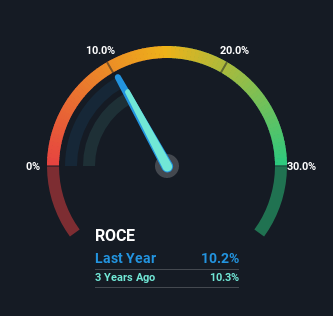- Switzerland
- /
- Telecom Services and Carriers
- /
- SWX:SCMN
Return Trends At Swisscom (VTX:SCMN) Aren't Appealing

There are a few key trends to look for if we want to identify the next multi-bagger. Ideally, a business will show two trends; firstly a growing return on capital employed (ROCE) and secondly, an increasing amount of capital employed. Put simply, these types of businesses are compounding machines, meaning they are continually reinvesting their earnings at ever-higher rates of return. Having said that, from a first glance at Swisscom (VTX:SCMN) we aren't jumping out of our chairs at how returns are trending, but let's have a deeper look.
What is Return On Capital Employed (ROCE)?
If you haven't worked with ROCE before, it measures the 'return' (pre-tax profit) a company generates from capital employed in its business. Analysts use this formula to calculate it for Swisscom:
Return on Capital Employed = Earnings Before Interest and Tax (EBIT) ÷ (Total Assets - Current Liabilities)
0.10 = CHF2.1b ÷ (CHF25b - CHF4.2b) (Based on the trailing twelve months to March 2022).
So, Swisscom has an ROCE of 10%. That's a relatively normal return on capital, and it's around the 9.4% generated by the Telecom industry.
See our latest analysis for Swisscom

Above you can see how the current ROCE for Swisscom compares to its prior returns on capital, but there's only so much you can tell from the past. If you'd like, you can check out the forecasts from the analysts covering Swisscom here for free.
How Are Returns Trending?
Over the past five years, Swisscom's ROCE and capital employed have both remained mostly flat. Businesses with these traits tend to be mature and steady operations because they're past the growth phase. So don't be surprised if Swisscom doesn't end up being a multi-bagger in a few years time. That probably explains why Swisscom has been paying out 76% of its earnings as dividends to shareholders. Most shareholders probably know this and own the stock for its dividend.
The Bottom Line
We can conclude that in regards to Swisscom's returns on capital employed and the trends, there isn't much change to report on. Although the market must be expecting these trends to improve because the stock has gained 58% over the last five years. Ultimately, if the underlying trends persist, we wouldn't hold our breath on it being a multi-bagger going forward.
If you want to know some of the risks facing Swisscom we've found 2 warning signs (1 can't be ignored!) that you should be aware of before investing here.
While Swisscom isn't earning the highest return, check out this free list of companies that are earning high returns on equity with solid balance sheets.
New: Manage All Your Stock Portfolios in One Place
We've created the ultimate portfolio companion for stock investors, and it's free.
• Connect an unlimited number of Portfolios and see your total in one currency
• Be alerted to new Warning Signs or Risks via email or mobile
• Track the Fair Value of your stocks
Have feedback on this article? Concerned about the content? Get in touch with us directly. Alternatively, email editorial-team (at) simplywallst.com.
This article by Simply Wall St is general in nature. We provide commentary based on historical data and analyst forecasts only using an unbiased methodology and our articles are not intended to be financial advice. It does not constitute a recommendation to buy or sell any stock, and does not take account of your objectives, or your financial situation. We aim to bring you long-term focused analysis driven by fundamental data. Note that our analysis may not factor in the latest price-sensitive company announcements or qualitative material. Simply Wall St has no position in any stocks mentioned.
About SWX:SCMN
Swisscom
Provides telecommunication services primarily in Switzerland, Italy, and internationally.
Good value with adequate balance sheet and pays a dividend.


